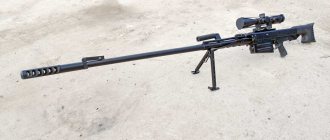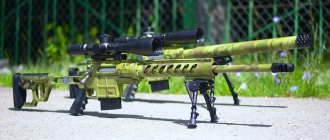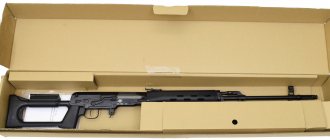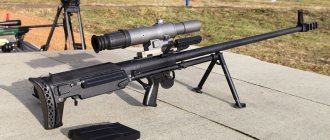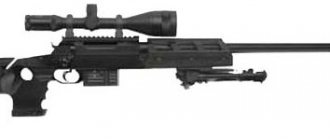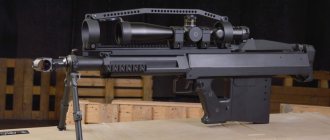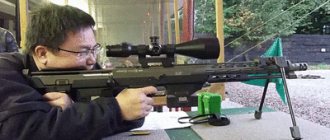Sniper rifle Knights SR-25, Mk.11 Mod.0 and XM110 (USA)
Knights SR-25 sniper/match rifle, civilian version with 50 cm barrel.
Knights SR-25 carbine, civilian/police version with 40 cm barrel and extendable stock.
Mark 11 Model 0 (Mk.11 Mod.0) sniper rifle with a 10-round magazine.
Mark 11 Model 0 (Mk.11 Mod.0) sniper rifle with a 20-round magazine and a silencer installed.
Sniper rifle XM110 Semi-Automatic Sniper Rifle (XM110 SASR) with a 20-round magazine and a silencer installed.
| SR 25 rifle | SR 25 carbine | MK 11 Mod 0 | XM 110 | |
| Caliber | 7.62×51 NATO / .308 Winchester | |||
| Mechanism | semi-automatic gas-operated, locking by turning the bolt | |||
| Length | 1118 mm | 940 / 860 mm | 1158 mm | 1187 - 1200 mm |
| Barrel length | 508 mm | 406 mm | 508 mm | 508 mm |
| Weight | 4.31 kg (without sight and magazine) | 3.86 kg (without sight and magazine) | 6.9 kg (with bipod and sight, without magazine) | 7.26 kg (with bipod and sight, without magazine) |
| Shop | 10 or 20 rounds, detachable box | |||
The SR-25 rifle was developed by Eugene Stoner (one of the creators of the Ar-15 / M16 rifle) in the early 1990s, when he collaborated with the American company Knight's Armaments Co. The SR-25 rifle (Stoner Rifle model 25) is based on the design of the Ar-15 rifle, modified for the 7.62x51 cartridge. The SR-25 rifle turned out to be quite successful; it provided high shooting accuracy and therefore became popular both among civilian shooters in the United States and among police snipers. In the nineties, a version of this rifle, complete with an optical sight and a quick-detachable silencer from the same company, was adopted by the US Navy Special Operations Forces under the designation Mark 11 Model 0 (Mk.11 Mod.0) sniper rifle. Later, under the same designation, rifles began to enter service with snipers of the US Marine Corps. In 2005, as a result of competitive testing of the XM110, a slightly modified version of the Mk.11 Mod.0 rifle was adopted by US Army snipers under the designation XM110 / M110 Semi-Automatic Sniper Rifle (M110 SASR). The XM110 rifles should eventually replace the M24 magazine sniper rifles in service. The main purpose of the Mk.11 Mod.0 and XM110 rifles is aimed fire at enemy personnel at ranges of up to 800 meters. From a tactical point of view, these rifles are analogues of the Dragunov SVD sniper rifle, however, they are distinguished by higher shooting accuracy (including due to the presence of higher quality cartridges) and greater tactical flexibility due to a wide range of available sights and the presence of a quick-detachable shot silencer.
The SR-25 rifle uses automatic gas venting with the removal of powder gases into the body of the bolt frame (Stoner system). The barrel is locked by turning the bolt, which has 7 lugs. The receiver consists of two halves connected by transverse pins and made of a special aluminum alloy. The rifle barrel is cantilevered and does not touch the fore-end, which ensures shooting stability. On the upper part of the receiver and on the forend there are Picatinny rail type guides for installing sights and other accessories. The trigger mechanism allows firing only single shots and is optimized for accurate shooting. Standard sighting devices include folding front and rear sights mounted on quick-release brackets; diopter rear sight adjustable for range up to 600 meters. In the daytime, “military” versions are used with a Leupold optical sight of variable magnification 3.5-10X. In the dark, it is possible to use various night and IR sights. The “military” version of the XM110 / M110 rifle differs from the “naval” Mk.11 in the ability to adjust the length of the butt, a different design of the forend with integral Picatinny rail type guides, the presence of a flash suppressor on the barrel, as well as a different coloring of the outer surfaces. All combat versions of the rifle are also equipped with a removable folding bipod from Harris, a quick-detachable shot silencer, a carrying strap, a case and other necessary accessories.
Users[edit]
- Australia: Australian Army, [6] Australian Air Force Air Defense Guards [7] and Police Tactical Group. [8] [9]
- Israel: IDF special forces and Yamam (Police SWAT and CT unit). [10]
- Philippines: Philippine National Police Special Action Force, [11] Philippine Army Light Reaction Regiment [12] [ more detailed source needed
] - Poland: GROM. [13]
- Thailand: Royal Thai Army. [14]
- Turkey: Gendarmerie General Command [15] [ page needed
] - USA: US Military [16]
Peculiarity
This is a long-barreled weapon of a traditional layout with magazine ammunition and manual reloading. It is possible to install various sights and other equipment, for which there are rails. A folding stock with several degrees of adjustment, characteristic of DXL series rifles, is also used. The main feature of the new rifle is modularity. In "Devastator" it became possible for the sniper to replace the barrel with two calibers: NATO 50 BMG and domestic 12.77x108. This is primarily done in order to increase the export prospects of weapons.
How the compatibility of the bolt group with different cartridges is ensured is unknown. Experts suggest that the ability to use different calibers is ensured by replacing just a couple of key parts. However, the developer has not yet specified how quickly and easily such a replacement is carried out. We should also not forget that versatility does not always pay off. Combining different functions and capabilities in one sample can lead to specific disadvantages and problems. The DXL-5 rifle has so far been made in only one caliber and is undergoing first tests. She has yet to show her performance and effectiveness in all planned options.
Exact replacement. The new weapon for army snipers will be the Chukavina rifle. Read more
History of creation
The developer of the rifle is the Russian arms company Lobaev Arms. Last year, gunsmiths announced that they were working on creating a sniper system that would include a rifle and a cartridge with improved precision fire range characteristics. Due to the pandemic, development was delayed. At the end of October, the company published a short video with individual parts of the prototype rifle. On November 19, the experimental rifle was shown assembled for the first time. They also revealed the key features of the project and its new capabilities. The tactical and technical characteristics of the product were not mentioned. The rifle is currently ready for testing. The test will take place in several stages, which will allow you to consistently test several versions of the weapon.
Purpose
Snipers armed with the Devastator are expected to perform one of the most difficult missions in modern combat: fighting enemy sniper units. The developer claims that the DXL-5 has a unique accuracy of 0.5 arc minutes for the 12.7 caliber, which means that the rifle shoots four times more accurately than its American competitor Barret (2 arc minutes). The target firing range is about 2300 meters. For comparison: Barrett has 1800.
https://ria.ru/20211221/vintovka-1764638273.html
Project evaluation
Apparently, the American military has very serious plans for the FN SCAR shooting system. It was successfully tested in the harsh conditions of Afghanistan and Iraq, where it proved itself to be a reliable and effective weapon. And this is not the only advantage of the rifle:
- High versatility. Thanks to the modular design of the FN SCAR, it can be transformed in a matter of minutes into exactly the weapon needed for a specific mission. The rifle can be equipped with a bipod, an under-barrel grenade launcher, various sighting devices, a tactical flashlight and other attachments.
- Excellent accuracy and accuracy of fire, and this applies to both single-shot shooting and automatic fire.
- Reliability. The rifle is made according to a design very similar to the Kalashnikov assault rifle. It is easy to assemble and disassemble and can be repaired even in the field. The weapon is insensitive to clogging; the use of the rifle in Afghanistan and Iraq has shown that it is not afraid of fine sand getting inside (an almost incurable disease of the M16 and its modifications).
- Ergonomics. The rifle is very comfortable, we can say that its ergonomics are at the level of the world's best small automatic weapons. You can shoot with both the left and the right hand. The safety keys and the magazine eject button are convenient and duplicated on both sides of the weapon. The rifle has an adjustable buttstock equipped with a thick rubber butt pad that partially absorbs recoil. By the way, the recoil itself is quite low, as for an automatic weapon.
If we talk about disadvantages, there are relatively few of them:
- Even a standard modification rifle is heavier than the usual M16.
- The weapon is absolutely not intended for hand-to-hand combat, which is not surprising, since the rifle was originally developed for special troops.
- FN SCAR has a fairly high price: from 2700 to 3000 dollars.
It should also be noted that the rifle’s rate of fire is slightly lower (approximately 600 rounds per minute) compared to other types of similar weapons. However, this is a very controversial drawback. Low rate of fire improves automatic fire accuracy and reduces ammo consumption.
Know-how
Another technological know-how introduced on the DXL-5 is a damping device on the stock, which significantly reduces the recoil effect of the 13 kg rifle.
This sniper rifle will become a “laboratory” for testing new calibers. Four new calibers have been developed specifically for it, which will be tested in the near future. This will allow us to achieve higher firing ranges for weapons of this class. Perhaps this is a future competitor to another rifle: SVLK-14 “Twilight”. It is currently the longest-range rifle in the world. Using this weapon, Russian Andrei Ryabinsky set a world record, hitting a target at a distance of 4210 meters.

